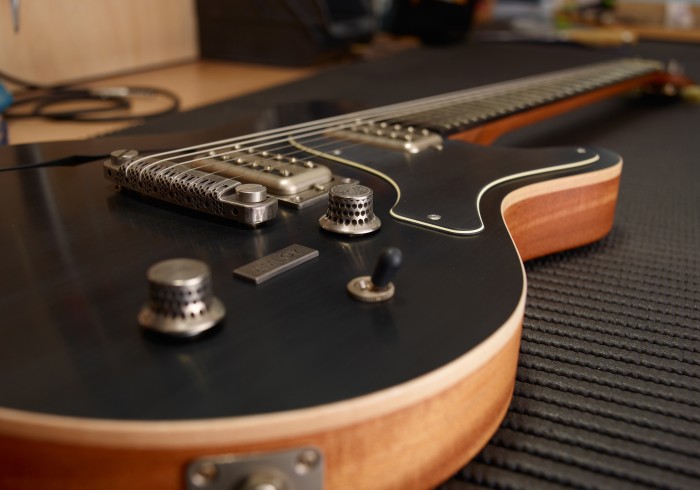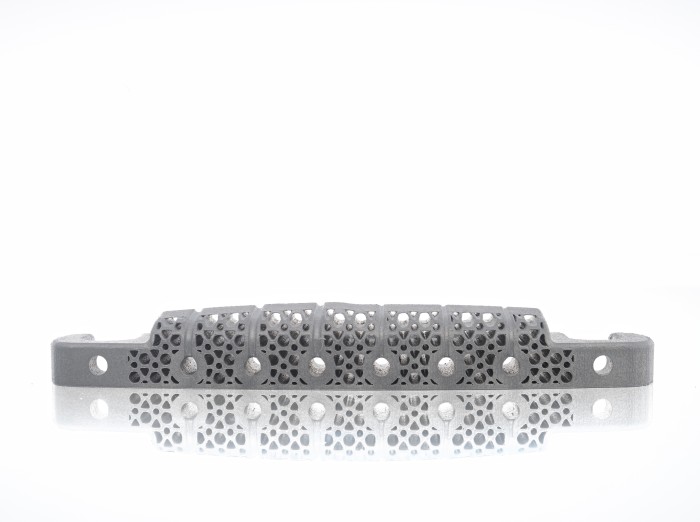Nik Huber Guitars, a guitar manufacturer based in Germany, has partnered with amorphous metal specialists Heraeus AMLOY, to install a 3D printed bridge made from amorphous metal on one of its guitars.
Nik Huber Guitars wanted to try out a material for developing one of its guitars in order to improve its sound characteristics. Amorphous metals, which maintain atomic structural properties akin to glass, are particularly elastic, enabling efficient transmission of vibrations. The material, therefore, provides a set of properties that make it suitable for guitar manufacturing, an industry that has rarely experimented with different materials, according to Nik Huber, Founder, and CEO of Nik Huber Guitars: “3D-printed amorphous metals are a promising material for guitar building due to their unique properties.”
“Especially in our conservative guitar market it is important to be open for further developments but also new materials and technologies.”

Heraeus amorphous metals
Founded in 1996, Nik Huber Guitars has been building hand-crafted guitars for 24 years. Today, Nik Huber and his team produce around 240 instruments a year. Seeking to innovate its guitars and quality of sound, the company is open to leveraging new materials such as special woods or metals.
As such, it sought the services of Heraeus AMLOY, the company that 3D printed the amorphous bridge. Heraeus AMLOY is the amorphous metals division of Heraeus, a German technology group specializing in precious metals. Heraeus was founded in 1851, and today spans businesses in the environmental, energy, electronics, health, mobility, and industrial applications sectors. The company has placed significant effort towards the development of 3D printed amorphous metals, having been working on them since 2016, where it first included the material in its portfolio of 3D printing metals. In April 2019, Heraeus claimed to have manufactured the “largest amorphous metal component” using additive manufacturing.

What are amorphous metals?
Amorphous metals are formed through the rapid cooling of molten metal. The rate of cooling is too fast for the material’s atoms to form a crystalline structure. Instead, the atoms solidify in an amorphous, disordered manner, locking the metal in a non-crystalline glassy state. Most metals are crystalline in their solid-state, which means they have a highly ordered arrangement of atoms. Amorphous metals are also scratch and corrosion resistant, and highly biocompatible.
The nature of amorphous metals presents great potential uses in metal 3D printing. For example, NASA has explored the benefits of using the material in its spacecraft when exploring harsh environments. Tobias Caspari, SVP of Additive Manufacturing at Heraeus, has previously highlighted potential uses, “Amorphous metals will change our future. They possess a wide variety of previously incompatible characteristics: They are very strong and yet malleable, as well as harder and more corrosion-resistant than conventional metals.”
The 3D printed amorphous bridge
Jürgen Wachter, Head of Heraeus AMLOY, explains that amorphous metals are “ideally suited for stringed instruments such as guitars.” Explaining the reason why, Wachter states that “Since amorphous metals are significantly more elastic than crystalline materials, they transmit vibrations very well.” Additional benefits to guitar manufacturing include the metal’s scratch and corrosion resistance, preventing wear to the bridge and the need for eventual replacement.

Thanks to the design freedom enabled by 3D printing, the bridge does not have a conventionally solid structure like most bridges. Instead, it has an internal honeycomb structure, which has a significant effect on the vibration period of the bridge, as it dampens the vibrations less than closed, solid structures. This can, therefore, make a prominent difference to the sound properties.
“One could also imitate the sound of other metals by changing the structures inside the bridge,” adds Jürgen Wachter. “A bridge made of amorphous metal would then sound like a bridge made of brass, for example. The difference is that due to its elasticity it keeps the sound longer, does not wear out and still looks like new even after years.”
Nominations for the 2020 3D Printing Industry Awards are now open. Who do you think should make the shortlists for this year’s show? Have your say now.
Subscribe to the 3D Printing Industry newsletter for the latest news in additive manufacturing. You can also stay connected by following us on Twitter and liking us on Facebook.
Looking for a career in additive manufacturing? Visit 3D Printing Jobs for a selection of roles in the industry.
Featured image shows the guitar with 3D printed amorphous metal bridge. Photo via Heraeus.

